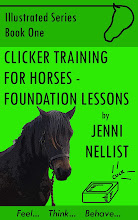When people talk about having a connection with their horse, where the communication between horse and person is invisible or once you know what they’re doing, nearly invisible I’m reminded of the Clever Hans story.
For those who don’t know Clever Hans could count and do maths, and counted out the answer by pawing the ground. But actually he couldn’t. His skills were scrutinised and it was found that if his owner didn’t know the answer, he didn’t either. What he could do well was read his person! He would watch his owner, Herr von Osten, and paw the ground when he saw a very, very slight downward movement of von Osten’s head, and then stop when von Osten very, very slightly raised it again when the ‘right answer’ was reached. Initially von Osten denied helping his horse in these puzzles, and quite possibly he was not aware that he was helping his horse. It took a very observant student to notice what was actually happening. Horses are amazing observers and I think that is part of the ‘pure connection’ that people talk about – horses are ready to receive information.
I think that connection is based on three things: attraction, empathy (at least from the human) and communication. We are intrinsically attracted to our horses, for one reason or another. We are ready to communicate with them, but there has to be a ‘how to’. That ‘how to’ is empathy – to feel for – and communication, and what we communicate to the horse will affect how attracted he or she is to us.
With attraction and empathy our channels of communication with the horse are set to ‘ready to receive’. I think all people who are very good with horses are ‘ready to receive’. And once ready to receive, we can then be ‘ready to respond accordingly’. That’s where timing our communication signals comes in – sending the message when the recipient is ready to receive. I think that in good horsemanship it’s working both ways, if we send messages when the horse indicates through his or her behaviour that he or she is ready to receive, then the horse learns when and how to open lines of communication with us.
I also think that communication is learned, that we co-create a language with our horse. I do get a bit behaviouristic about this. Having my communications received and responded to in the manner that I wanted is reinforcing – if I signal ‘please do this’ to my horse, and she does so in response, then I’ve got what I wanted and am more likely to do it again in future. I may also learn to make this request when my mare is attentive to me, so she learns how to communicate to me to cue her to do something that invariable ends up in reinforcement for her and so we both become more sensitive or ‘connected’ to each other.
Scientific definition
Reinforcement: A consequence of behaviour that makes the individual more likely to perform that specific behaviour under the same circumstances in future.
In my experience horses tend to ask for opportunities to get positive reinforcement more often than they do negative reinforcement unless they are stuck in a pickle as it were. Positive reinforcement is more pleasing to the horse, and a pleased horse is more pleasing to me. I don’t like my horse to get in pickle, so mostly she’ll be getting positive reinforcement – for her those things are food when she’s in the mood (that’s a lot!), scratches when she’s in the mood (“but there’s only so much scratching I like Jen”), and a canter up the common when she’s in the mood (quite often these days as she’s leaner and meaner). This all means that I don’t think food, when used most deliberately, gets in the way of greater sensitivity or connection to each other, but it will if there is no understanding about how it is given – from either party, horse or person!
Scientific definition
Positive reinforcement: To ADD a rewarding stimulus to the individual as a consequence of behaviour increasing the likelihood of that behaviour occurring in future.
Negative reinforcement: To REMOVE an aversive stimulus from the individual as a consequence of behaviour also increasing the likelihood of that behaviour occurring in future.
If a person wishes to become a horseperson who has a connection with his or her horses, that person needs to love horses, needs to understand what their horse’s behaviour means to their horse, and needs to learn how the laws of learning work and are applied (not necessarily in academic language, it’s practical application that’s at stake). Then they may become a horseperson and realise that the state of being for a horseperson is lifelong personal development. So yes, like Ghandi they may be different today as the result of what they learned yesterday – I know I am.
Saturday, 21 January 2012
Subscribe to:
Posts (Atom)

